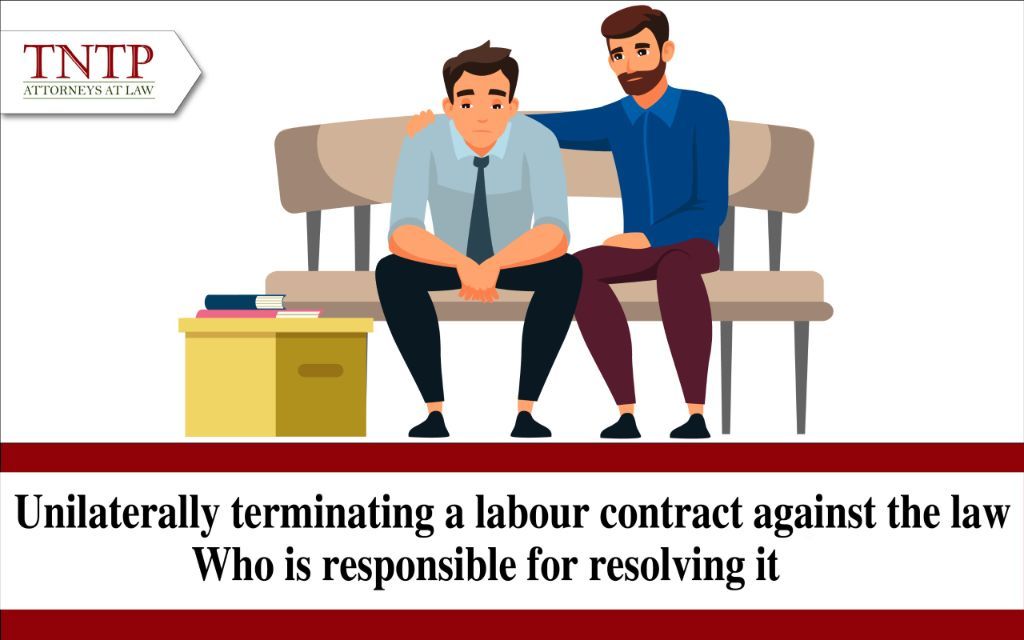Unilaterally terminating a labour contract against the law – Who is responsible for resolving it?

If the employee faces unlawful unilateral termination of the labour contract, the employee has the right to request relevant individuals, organizations, and authorities to resolve the dispute on their behalf. In the following article, TNTP will present some individuals, organizations, and authorities that assist in resolving disputes for terminating a labour contract
1. Representative Organization of Employees
The representative organization of employees means an internal organization voluntarily established by employees of an employer which protects the employees’ legitimate rights and interests in labour relations through collective bargaining or other methods prescribed by labour laws. Representative organizations of employees include internal trade unions and internal employee organizations.
Therefore, it can be seen that the representative organization of employees is established to protect the legitimate rights of employees. When the employee’s rights are violated, the employee can request this organization to resolve disputes related to the employer’s unlawful unilateral termination of the labour contract.
2. Employer
When the employee believes that the employer has unlawfully terminated the labour contract and has evidence to support this claim, the employee should first engage in negotiations with the employer. Negotiations can be conducted through written communication, emails, online meetings, or in-person discussions. If the employer is cooperative, both parties can agree on a suitable resolution based on their mutual interests. If the employer maintains her/his opinion or refuses to engage, the employee can draft a formal complaint to submit to the employer. This serves as evidence that the employee has initiated the first complaint to the employer, after which the employee can proceed to file a second complaint with the Chief Inspector of the Department of Labour – Invalids and Social Affairs.
3. Chief Inspector of the Department of Labour – Invalids and Social Affairs
The Employee can request the Chief Inspector of the Department of Labour – Invalids and Social Affairs at the location where the enterprise is headquartered to handle the second complaint when the employee disagrees with the initial resolution by the employer or when the prescribed time limit for resolution has passed.
The time limit for resolving the initial complaint is no more than 30 days from the date of acceptance; for complex cases, the time limit is no more than 45 days from the date of acceptance. In remote or difficult-to-reach areas, the time limit is no more than 45 days from the date of acceptance; for complex cases in these areas, the time limit is no more than 60 days from the date of acceptance.
4. Labour Mediator
The employee can request a labour mediator to resolve the dispute with the employer. Labour mediators have the responsibility to guide and support the parties in negotiations to resolve.
5. Labour Arbitration Council
In cases where the employee and the employer agree to resolve the dispute through the Labour Arbitration Council, both parties have the right to request the Labour Arbitration Council to handle the dispute according to legal regulations.
6. Competent Court
After unsuccessful negotiations with the employer, most employees resort to litigation in the competent Court due to the effectiveness of this method.
Firstly, disputes regarding unlawful unilateral termination of the labour contract do not require mandatory mediation by a labour mediator. Therefore, employees can directly initiate legal proceedings in the competent Court.
Secondly, employees are exempt from paying advance court fees and court fees when initiating proceedings to resolve disputes related to unlawful termination of the labour contract. To be exempt from these fees, employees need to submit a request for exemption or reduction of court fees along with relevant documents and evidence of eligibility.
Thirdly, in cases where the Court issues a favourable judgment/decision for the employee, the employee has the right to request enforcement authorities to compel the employer to execute the Court’s judgment/decision. This is arguably the most effective approach to litigation, as in other resolution methods, even if both parties agree on terms favourable to the employee, the employer’s non-compliance would not allow the employee to enforce the terms. Therefore, the employee can continue to pursue litigation in the competent Court.
7. Other Individuals, Organizations, and Authorities
Employees can request other relevant organizations and authorities to safeguard their rights and interests. These include social insurance agencies (in cases involving disputes related to insurance contributions, failure to record social insurance, etc.), the Vietnam General Confederation of Labour, the Labor Union of the city where the employer is headquartered, etc.
Additionally, employees can consider engaging legal services from lawyers specializing in labour law. Lawyers can propose resolution strategies, draft necessary documents, provide advice, and represent employees in protecting their rights and interests.
The above is the article “Unilaterally terminating a labour contract against the law – Who is responsible for resolving it?” that TNTP presents to readers. Should there be any issues requiring discussion, please contact TNTP for assistance.
Sincerely,



